Psychology > QUESTIONS & ANSWERS > WGU C180 Assessment Questions with accurate answers, Graded A+ (All)
WGU C180 Assessment Questions with accurate answers, Graded A+
Document Content and Description Below
WGU C180 Assessment Questions with accurate answers, Graded A+ What do psychologists study? - ✔✔-• Biological Foundations -biological processes, in the brain, hormones, and DNA, items that ... influence thoughts and behaviors. • Mental Life -thought processes of people, e.g. when they solve problems • Change- Psychologists study how individuals change mentally, emotionally, and socially as they age, from infants to children to teens to adults to seniors • Self and Others - how people judge themselves, and how they relate to other individuals • Potential and Dysfunction - Psychologists study variations in perception, cognition, and emotions, to define what is normal and what is exceptional, and what is dysfunctional How is the scientific method applied to psychological research? - ✔✔-The scientific method is the set of rules, and procedures used in conducting research. In addition to requiring that science is verifiable, the scientific method demands that procedures are free of personal bias. Steps of the scientific method 1. Form Hypothesis 2. Conduct Research 3. Analyze Data 4. Interpret Data 5. Publish Results What is the definition of hypothesis? - ✔✔-A theory is based on principles that are general and can be applied to many situations. A questions must be stated in a hypothesis which is a statement quessing the relationship among certain parts of a theory. 3. What is an operational definition? Provide an example. - ✔✔-An operational definition refers to a precise statement of how a conceptual variable is turned into a measured variable (Conceptual Variable) Depression (Operational definition) number of appointments made with a psychotherapist 4. Why are ethical guidelines needed within psychological research? What are some requirements of ethical research? - ✔✔-Ethical guidelines are needed with psychological research is the prevent physical/emotional harm to the participants. Free choice in participating, Allowed to ask questions, able to quit at any point What are the various research methods in the field of psychology? - ✔✔-• Descriptive is research designed to provide a snapshot of the current state of affairs. • Correlational is research designed to discover relationships among variables • Experimental research is research in which there is a random assignment people into two groups. You manipulate the experience for one group while the control group is not. What is the relationship between a population and a sample? - ✔✔-Sample represents the population Identify major elements of a psychological experiment by describing an example of an experiment. Use the terms independent variable, dependent variable, control group, and experimental group. - ✔✔-In an experimental research design, the variables of interest are called the independent variable(s) [the causing variable that is created (manipulated) by the experiment] and the dependent variable [a measured variable that is expected to be influenced by the experiment] . The research hypothesis suggests that the manipulated independent variable or variables will cause changes in the measured dependent variables. An example of the use of these independent and dependent variables in an experiment is the effect of witnessing aggression on children's aggressive behaviors. In a classic study conducted by Albert Bandura in 1961, it was revealed that children who first watched an adult demonstrating violent behavior on a Bobo doll (inflatable clown with sand at the base) in a play room were more likely to show the same aggressive behaviors, compared to children who watched a passive adult in the play room or no adult at all in the play room before each child entered the play room. The independent variable manipulated by the experimenter was viewing violent behavior with the Bobo doll. The dependent variable, or the measure of behavior, was whether the child in a play room by his or herself expressed aggression by hitting a Bobo doll. The operational definition of this dependent variable was the number of hits, kicks, and other displays of aggression the child inflicted on the Bobo doll. 5. What does a correlational research design examine? Provide an example - ✔✔-Correlational research is research designed to discover relationships among variables and to allow the prediction of future events from present knowledge. The variables of height and weight are systematically related (correlated) because taller people generally weigh more than shorter people. Describe examples of a positive and a negative correlation - ✔✔-Correlational-To assess the relationships between and among two or more variables. Postiive - As children age they get better at math Negative - Age of a child and the number of diapers they use What are the differences in interpretations of correlational and experimental designs? - ✔✔-In correlational studies a researcher looks for relations between naturally occurring variables, whereas in experimental studies the researcher introduces a change and then monitors its effects. Identify the function of each of these four parts of a neuron and its role in neural communication. - ✔✔- Cell Body (Soma)-contains the nucleus of the cell and keeps the cell alive Dendrites- branching, treelike fiber which collects information from other cells and sends the information to the soma Axon-a long, segmented fiber which transmits information away from the cell body toward other neurons or to the muscles and glands. Myelin Sheath-Covers the axon of some neurons and helps speed neural impulses What is a neurotransmitter? What are some examples of neurotransmitters? - ✔✔-Neurochemical messengers that are released by terminal buttons when an action potential triggers them. A few examples of neuro transmitters are: ACh: Used in spinal cord to simulate muscle contractions and in brain to regulate memory, sleeping and dreaming. Udersupply associated with Alzheimer's disease. Dopamine: Used as brains reward system. Involved in movement, motivation, and emotion. Used in learning. Increase = Schizophrenia. Under supply = Parkinsons Endorphins: Released in response to behaviors such as exercise, orgasam, and eating. Nataural pain reliever. Creates a runners high. GABA: Major inhibitory neurotransmitter. Linked to sizures. Glutamate: cause overstimulation, migraines, and seizurs. Most common neurotransmitter. Serotonin: Inovlved in mood, appetite, sleep and aggression. Low levels associated with depressions. Where are neurotransmitters stored? How do they communicate between neurons? - ✔✔-If the signal reaches the terminal buttons, they are signaled to emit chemicals known as neurotransmitters, which communicate with other neurons across the spaces between the cells, known as synapses. describe the major functions for each brain part: - ✔✔-Cerebellum-(literally, "little brain") consists of two wrinkled ovals behind the brain stem. It functions to coordinate voluntary movement. Hypothalamus-Through its many interactions with other parts of the brain, the hypothalamus helps regulate body temperature, hunger, thirst, and sex drive and responds to the satisfaction of these needs by creating feelings of pleasure. Thalamus-the egg-shaped structure sitting just above the brain stem that applies still more filtering to the sensory information coming from the spinal cord and through the reticular formation, and it relays some of these remaining signals to the higher brain levels. Corpus callosum- Region that connects two halves of the brain and supports communication Hippocampus -The hippocampus consists of two "horns" that curve back from the amygdala. The hippocampus is important in storing information in long-term memory. Frontal lobe-(behind the forehead), which is responsible primarily for thinking, planning, memory, and judgment. Parietal lobe-parietal lobe, which extends from the middle to the back of the skull and is responsible primarily for processing information about touch. Temporal lobe-(pretty much between the ears) is the temporal lobe, responsible primarily for hearing and language. Occipital lobe-occipital lobe, at the very back of the skull, which processes visual information. describe the major function for each part of the endocrine system, which secretes chemical messengers called hormones that influence our emotions and behaviors. - ✔✔-Pancreas-Regulates the level of blood sugar in the blood Testes-Secreates male sex hormones Ovaries-Secreates female sex hormones Pituitary Gland-Secreates many different hormones, some of which affect other glands 1. What is the difference between sensation and perception? - ✔✔-sensation—awareness resulting from the stimulation of a sense organ perception—the organization and interpretation of sensations 2. What is the definition for the term absolute threshold? - ✔✔-the intensity of a stimulus that allows an organism to just barely detect it 3. What is subliminal messaging? How effective is subliminal messaging? - ✔✔-means "below the threshold" and only effective 50% of the time. A signal or message designed to pass below (sub) the normal limits of perception. An inaudible to the conscious mind (but audible to the unconscious or deeper mind) What is top-down processing? - ✔✔-we utilize preexisting expectancies and experiences to perceive the environment. For example, if your friend offers you a carton of milk and tells you she thinks it is spoiled, then you will now experience that milk using a top-down process. Your friend has created an expectation for you to find that the milk is indeed spoiled. If your friend had just handed the milk to you and let you take a drink for yourself, then you may not have found it to be spoiled at all. 5. What is inattentional blindness? - ✔✔-the ability to focus on some sensory inputs while tuning out others. Briefly, describe Pavlov's early work in classical conditioning. - ✔✔-In Pavlov's experiment, the sound of the tone served as the conditioned stimulus that, after learning, produced the conditioned response (CR), which is the acquired response to the formerly neutral stimulus. Note that the UR and the CR are the same behavior—in this case salivation—but they are given different names because they are produced by different stimuli (the US and the CS, respectively). What is classical conditioning? - ✔✔-refers to learning that occurs when a neutral stimulus (e.g., a tone) becomes associated with a stimulus (e.g., food) that naturally produces a specific behavior. an example of Pavlov's research with dogs... Now, using the last column in the table above, describe an example of classical conditioning from your personal or professional life. Identify the components. (CS, CR, US, UR) - ✔✔-Unconditioned Stimulus (US)-Food ex:Cat food Unconditioned Response (UR)-Salivation ex: Runs to food Conditioned Stimulus (CS)-Whistle ex:Ruffling of bag Conditioned Response (CR)-Salivation ex:Runs to food Cats run to their food if they see it. After noticing the ruffling of a bag is you getting their food out, they come to the sound of you ruffling the bag of their food. Provide an example of extinction. - ✔✔-You no longer fill the cats food bowl after ruffling a bag, so the cat no longer comes to that noise. Provide an example of generalization - ✔✔-The cat comes to the sound of any ruffling bag. 7. What is operant conditioning? Define and provide an example relevant to your work. - ✔✔-learning that occurs on the bases of the consequences of behavior and can involve the learning of new behaviors. Example: getting money for getting good grades on a report card 8. What are the differences between primary and secondary/conditioned reinforcers? Provide an example of each. - ✔✔-primary reinforcer includes stimuli that are naturally preferred or enjoyed by the organism, such as food, water, and relief from pain, a secondary reinforcer (sometimes called conditioned reinforcer) is a neutral event that has become associated with a primary reinforcer through classical conditioning. describe positive reinforcement, negative reinforcement, and punishment,and in a given situation, and provide an example of each. - ✔✔-Positive Reinforcement-Add or increase a pleasant stimulus ex:Giving a student a prize after he gets an A on a test Negative Reinforcement -Reduce or subtract an unpleasant stimulus ex:Taking painkillers that eliminate pain increases the likelihood that you will take painkillers again Positive Punishment-Present or add an unpleasant stimulus ex:Giving a student extra homework after she misbehaves in class Negative Punishment-Reduce or subtract a pleasant stimulus ex:Taking away a teen's computer after he misses curfew for each type of reinforcement schedule listed for a given situation, provide a brief explanation and an example - ✔✔-Fixed-Interval Behavior is reinforced after a specific number of responses Ex:People who get a monthly salary Variable-Interval Behavior is reinforced after an average, but unpredictable, number of responses Ex:Person who checks voice mail for messages Fixed-Ratio Behavior is reinforced for the first response after a specific amount of time has passed Ex: Factory workers who are paid according to the number of products they produce Variable-Ratio Behavior is reinforced for the first response after an average, but unpredictable, amount of time has passed Ex:Payoffs from slot machines 7. What is the difference between continuous reinforcement and partial reinforcement schedules? - ✔✔-Continuous reinforcement schedule, in which the desired response is reinforced every time it occurs; whenever the dog sits, for instance, it gets a biscuit. Most real-world reinforcers are not continuous; they occur on a partial (or intermittent) reinforcement schedule—a schedule in which the responses are sometimes reinforced, and sometimes not. In comparison to continuous reinforcement, partial reinforcement schedules lead to slower initial learning, but they also lead to greater resistance to extinction. 13. How is learning by insight different from classical and operant conditioning? - ✔✔-One type of learning that is not determined by classical conditioning (learned associations) or operant conditioning (based on trial-and-error) occurs when we suddenly find the solution to a problem, as if the idea just popped into our head. This type of learning is known as insight, the sudden understanding of a solution to a problem What is meant by latent learning? - ✔✔-Latent learning is learning that is not reinforced and not demonstrated until there is motivation to do so. 15. What are the main findings of Bandura's Bobo doll study and how does it demonstrate learning by observation? - ✔✔-Bandura and his colleagues (Bandura, A., Ross, D., and Ross, S. A., 1963) allowed children to watch an adult—a man or a woman in different conditions of the study—"playing" with a Bobo doll, an inflatable balloon with a weight in the bottom that makes it pop back up when you knock it down. Bandura wanted to know if watching the adults would influence the way the children behaved. They copied the adults for the positive reinformcent, but not did not when the adults were punished. What is the difference between implicit and explicit memory and the nature of processing for each? - ✔✔-Explicit memory - also called declarative memory; involves effortful processing and conscious awareness : Example - studying for an exam Implicit memory - also called non declarative memory; involves automatic processing, but not conscious awareness. Automatic memory, not meaning to Example - what you had for breakfast describe the provided memory store type and also it's capacity and/or duration. - ✔✔-Sensory memory= Iconic - Visual Sound - Echoic 2 seconds Short term memory= the place where small amounts of information can be temporarily kept Approximately 7 +/- 2 Less than a minute Long term memory=The place where information can be stored for long periods of time. Days, months and years. No known limit. What is the difference between short-term and working memory? - ✔✔-Short term memory - store memory temporarily Working memory - the strategy 4. What is chunking? Provide an example. - ✔✔-placing information into manageable parts in order to remember more. Example: 8018675309 - (801) 867-5309 What is the difference between encoding, storage, and retrieval in memory? In what order do they occur? - ✔✔-1. Encoding - Information acquired and processed into neural code (info entered with keyboard). 2. Storage - Information is stored in brain (stored on computer hard drive) 3. Retrieval - Information retrieved when needed ( just as it is showed on computer screen) What is an example of context-dependent memory? - ✔✔-Context-dependent learning refers to an increase in retrieval when the external situation in which information is learned matches the situation in which it is remembered. Example Environment What is an example of state-dependent memory? - ✔✔-State-dependent learning refers to superior retrieval of memories when the individual is in the same physiological or psychological state as during encoding. Example Emotion What is the serial position effect? - ✔✔-When we give people a list of words one at a time (e.g., on flashcards) and then ask them to recall them. People are able to retrieve more words that were presented to them at the beginning and the end of the list than they are words that were presented in the middle of the list. Anterograde amnesia - ✔✔-occurs when a person cannot create new memories typically after an accident or trauma. Retrograde amnesia - ✔✔-occurs when a person cannot recall information before an accident or trauma. What are the differences between proactive and retroactive interferences? - ✔✔-Proactive interference occurs when earlier learning impairs our ability to encode information that we try to learn later. Retroactive interference occurs when learning something new impairs our ability to retrieve information that was learned earlier you have been given a list of concepts or techniques. Describe on each row in the second column how these concepts can help you study and prepare for a test. - ✔✔-Elaborative encoding-Material is better remembered if it is processed more fully. Study more material that way it flows easier when testing. Spacing effect-Information is learned better when it is studied in shorter periods spaced over time. Study a little bit every day; do not cram at the last minute. This way you are more prepared for the test. Context-dependent retrieval-We have better retrieval when it occurs in the same situation in which we learned the material. If possible, study under conditions similar to the conditions under which you will take the exam. This way you are more comfortable when testing. What are some of the variables that can influence your accuracy of memories? - ✔✔-Cognitive biases are errors in memory or judgment that are caused by the inappropriate use of cognitive processes. misinformation effect refers to errors in memory that occur when new information influences existing memories What are flashbulb memories - ✔✔-flashbulb memory—a vivid and emotional memory of an unusual event that people believe they remember very well. Complete the following table of typical language development milestones by age - ✔✔-6 weeks By the time they are 6 to 8 weeks old, babies start making vowel sounds, called cooing ("ooohh," "aaahh," "goo") as well as a variety of cries and squeals to help them practice. 6 months At the same time infants are practicing their speaking skills by babbling, they are also learning to better understand sounds and eventually the words of language. One of the first words children understand is their own name, usually by about 6 months. 1 year At about 1 year of age, children begin to understand that words are more than sounds—they refer to particular objects and ideas. 2 years By the time children are 2 years old, they have a vocabulary of several hundred words, and by kindergarten, their vocabularies have increased to several th [Show More]
Last updated: 2 years ago
Preview 1 out of 26 pages

Buy this document to get the full access instantly
Instant Download Access after purchase
Buy NowInstant download
We Accept:

Also available in bundle (1)

WGU C180 BUNDLE. VERIFIED
WGU C180 Units, Top Exam Questions and answers, 100% Accurate, graded A+
By Topmark 2 years ago
$30
13
Reviews( 0 )
$11.00
Can't find what you want? Try our AI powered Search
Document information
Connected school, study & course
About the document
Uploaded On
Mar 13, 2023
Number of pages
26
Written in
Additional information
This document has been written for:
Uploaded
Mar 13, 2023
Downloads
0
Views
98

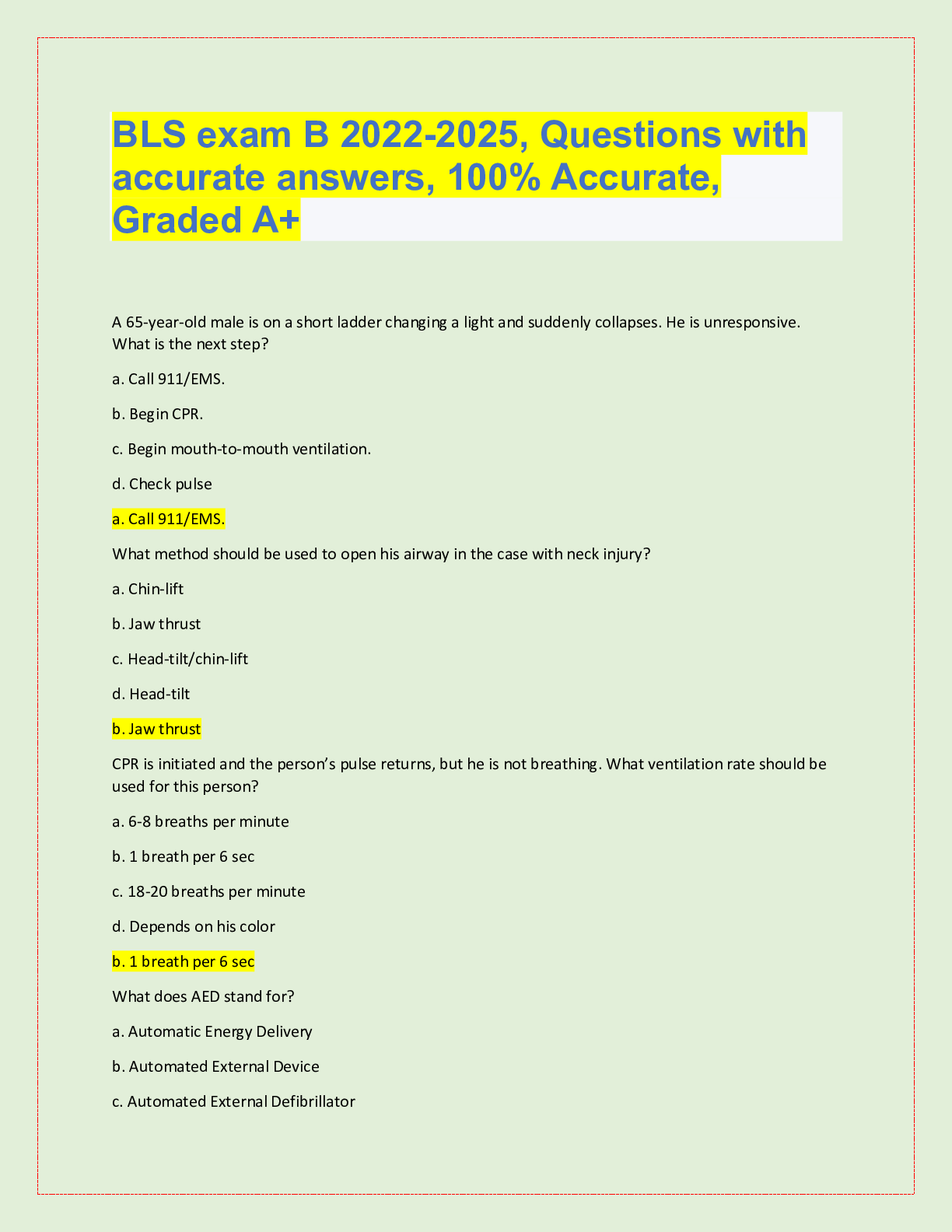












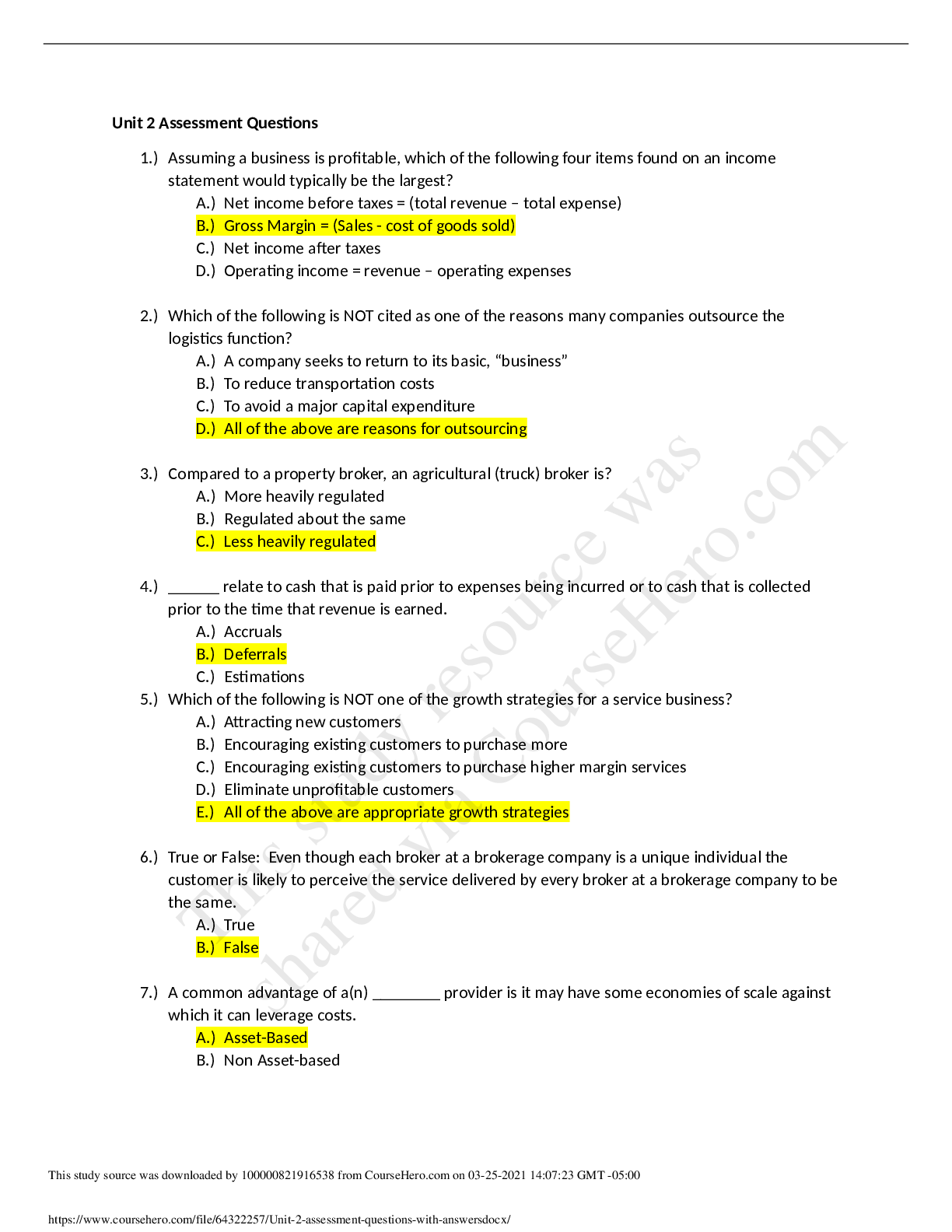
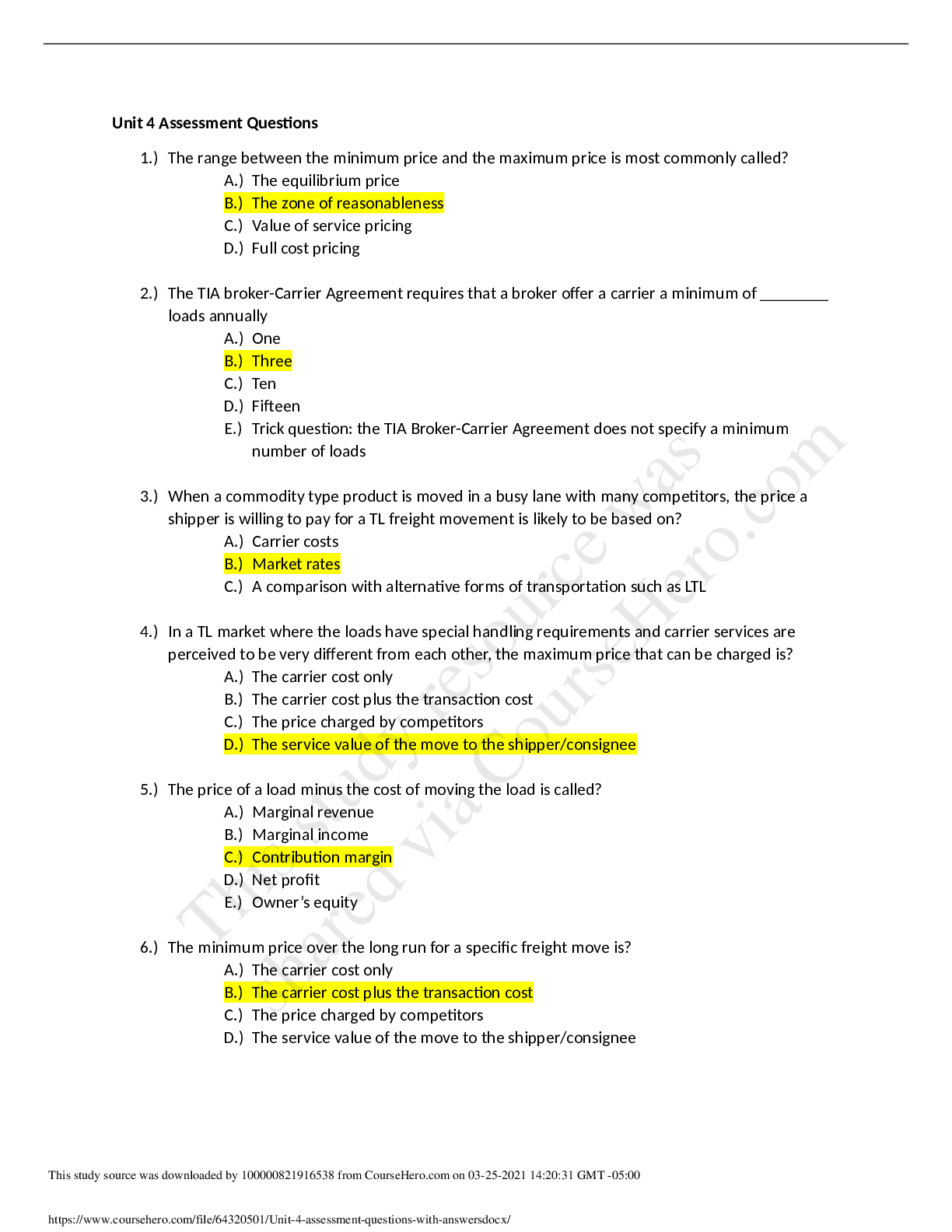
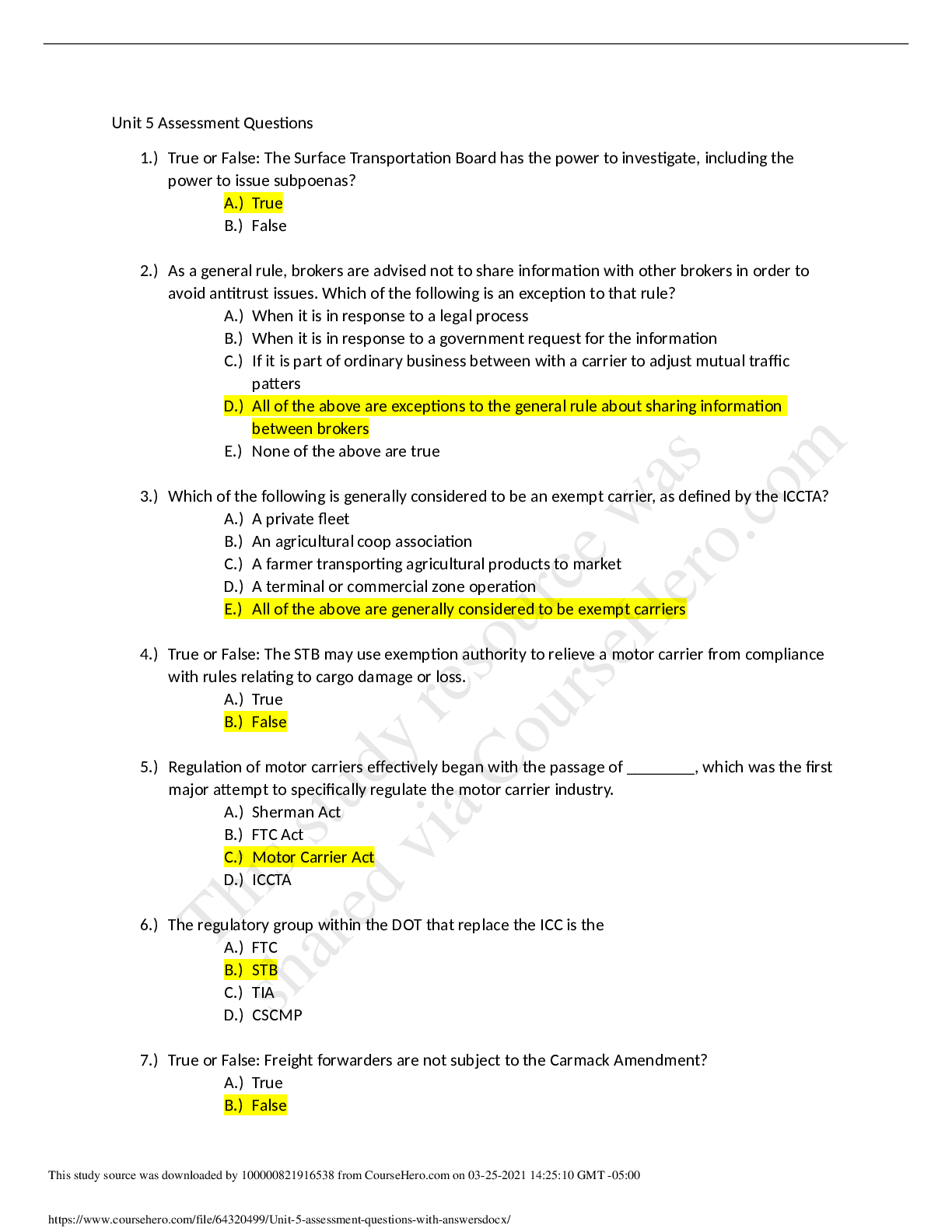
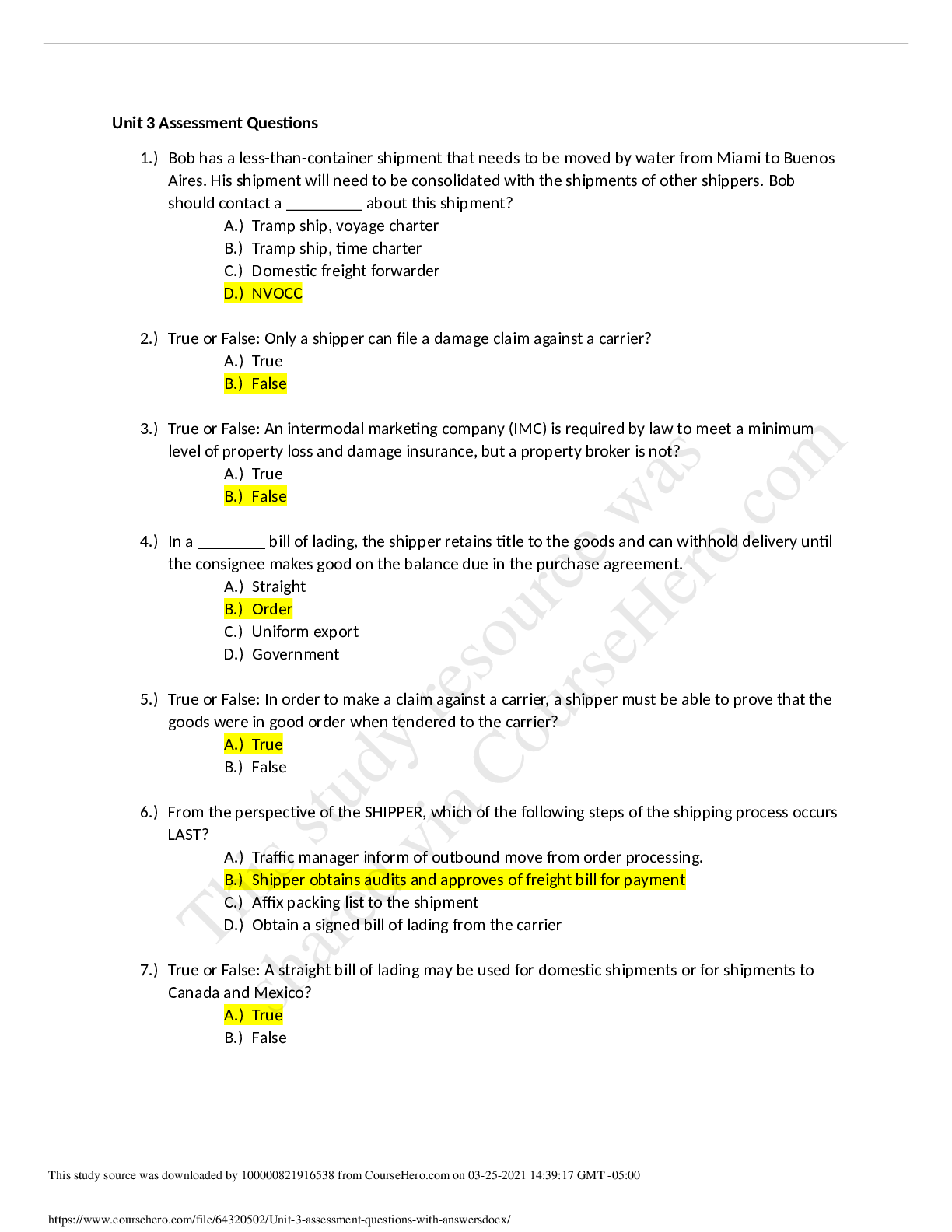

.png)


